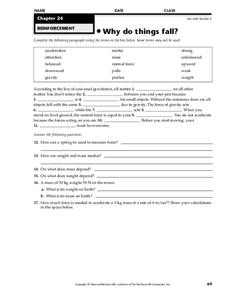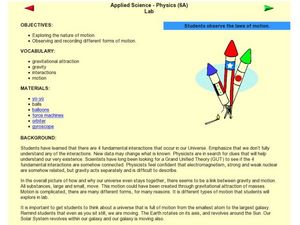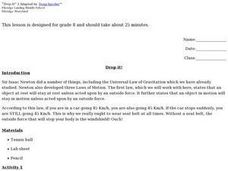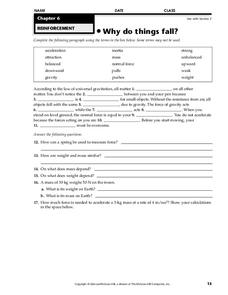CK-12 Foundation
Newton's Apple
Scientists state that the higher something is above the earth, the greater the gravitational potential energy. Does this mean there is more gravity acting on the moon than on an apple falling from a tree? Scholars adjust the distance...
Curated OER
MEASURING THE GRAVITATIONAL CONSTANT, G
Students study gravitational force an. In this gravitational force lesson plan students observe a demonstration.
Curated OER
Why Do Things Fall?
In this universal gravitation worksheet, students fill in the blanks to complete sentences with 11 given terms about gravity, inertia, acceleration, mass and force. Students also answer 7 questions about mass, weight and force.
Curated OER
Crash Course in Flight
High school physicists demonstrate Bernoulli's Principle by blowing on different items and finding that they do not move in the expected direction! They apply Bernoulli's equation to the flight of an airplane. This well-organized lesson...
NASA
Two Versions of Gravity: Newton and Einstein
We have all heard the debate about teaching both theories, but an innovative lesson plan takes the discussion to a new level. Scholars research and debate Newton's Law of Gravitation versus Einstein's General Theory of Relativity with...
NASA
Dark Matter NASA Conference
Young scholars calculate the escape velocity of planets in our solar system and use that knowledge to calculate the escape velocity for NGC 2300 group. They then suggest reasons for the escape velocity to be higher than possible given...
California Academy of Science
Kinesthetic Astronomy: Mars Opposition Dance
Your class will watch as one child orbits the sun as Earth, while another orbits as Mars. If the timing is right, they will see the repetitive dance between the two planets and discover how often they are opposite from each other. For...
Curated OER
Motion Experiment
Students experiment with the laws of motion. In this motion lesson, students explore Newton's Laws of Motion. Students work in groups experimenting with different objects and observing different types of motion.
Curated OER
Foucault's Pendulum
Students investigate how the motion of the Foucault pendulum proves that the Earth is rotating. They research the Internet about pendulums and conduct an experiment online. They view a multimedia presentation about pendulums and read...
Curated OER
Drop It!
Eighth graders explore Newton's Law of Motion that states that an object at rest stay at rest unless acted upon by an outside force and that an object in motion stay in motion unless acted upon by an outside force.
Curated OER
Johannes Kepler
In this online interactive history worksheet, students respond to 10 short answer and essay questions about the achievements of Johannes Kepler. Students may check some of their answers on the interactive worksheet.
Curated OER
A Classical & Relativistic Trip to a Black Hole
Students calculate distance, velocity, acceleration and time on their fantasy trip to the black hold. They apply Newton's Laws of Motion and calculate circular motion. They discuss any questions that may arise.
Flipping Physics
AP Physics 1: Electrostatics Review
AP Physics scholars will be excited to find this review of electrostatics as they prepare for the AP exam. Fast-paced, interesting, and comprehensive, the video also includes test-taking tips and common misconceptions.
Teach Engineering
Making Moon Craters
Create an egg-citing study of energy. Pupils investigate the effect of height and mass on the overall amount of energy of a falling object. The fourth segment in a six-part series on energy uses a weighted egg falling from different...
Curated OER
Free Fall
Students investigate the law of gravity and how an object can accelerate while going through a free fall. They examine the influence of air resistance and how it can influence the momentum of an object. The lesson contains background...
Curated OER
Solar System
Eighth graders identify the basic concepts of celestial bodies. They discover the difference between perihelion and aphelion and demonstrate how the universe is expanding. They also discover how gravity and centrifugal force are...
Curated OER
History of Astronomy
Students participate in assessments regarding the history of astronomy. They listen and take notes, draw a time line, draw a solar sytem designed by Ptolemy and create flashcards. They write an essay on Galileo, watch a video, take a...
American Chemical Society
Joseph Priestley, Discoverer of Oxygen
Do you want to hear a joke about nitrogen and oxygen? NO. We all know there is oxygen in the air and that plants produce oxygen, but how was it discovered? Scholars read a handout, answer questions, and analyze material in the...
Curated OER
Why Do Things Fall?
In this science activity, students complete a paragraph using 15 given terms. For example, "How can a spring be used to measure force?"
Laboratory for Atmospheric and Space Physics
The Planets and Scale
Scholars gain an insight into the relative size of planets and distance between inner and outer planets with the help of informational text, a data table, and a series of four questions.
University of Colorado
Modeling Sizes of Planets
The density of the huge planet of Saturn is 0.7 g/cm3, which means it could float in water! In the second part of 22, science pupils explore the size and order of the planets. They then calculate weight and/or gravity and density of...
Curated OER
WHAT HOLDS US TO EARTH?
Students they imagine they are Galileo and try to duplicate Galileo's experiments and results.
Curated OER
Applied Science - Built Environment (6) Lab
Sixth graders look at toys in space. In this gravity lesson, 6th graders make predictions about what different toys will do with zero gravity. They watch a space video and see what happens to these toys in space.
Curated OER
Projectile Motion: Hit the Army Men
Students predict the correct projectile launcher angle to hit the target. In this physics lesson, students record data on a spreadsheet. They curve their data and calculate the place of ball impact at an angle.

























